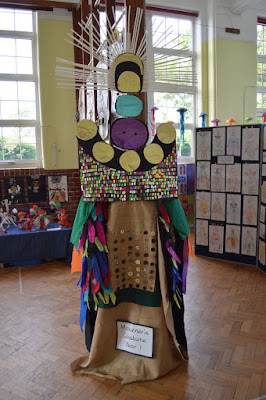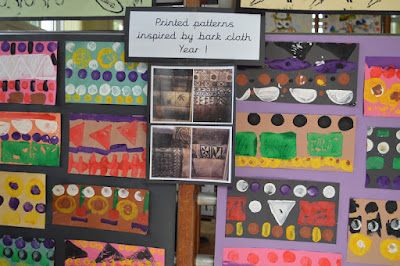 |
| Mourner's Costume 1886.1.1637.2.1© Pitt Rivers Museum |
 |
| Pupils present their costume design © Pitt Rivers Museum |
After the initial stimulus, schools can develop their own response to the object with explorers, costumes and ceremonies, and materials being key lines of enquiry. Teaching Notes available here. Take One... encourages a whole school celebratory event as demonstrated by West Oxford Community Primary School who used an art exhibition open to parents and the local community this week to showcase their response to the project. This was the culmination of every year group visiting the Museum in June to experience a Take One... session.
 |
| Replica Mourner Costume © Pitt Rivers Museum |
When I walked into the school hall at West Oxford Community Primary School I came face to face with a life-size replica of the Mourner Costume. I loved the way shiny paper had been used to resemble the pearl oyster apron, buttons imitated discs of coconut shell and crepe paper stood in for the barkcloth cape. This had been the masterpiece of Year 1, co-ordinated by Senior Teacher Liz Newman. I was also very excited to see the cloak designed by the Reception Class, ingeniously made from dyed wet-wipes. I was warned not to smell too closely as they had used potent dyes ranging from coffee, turmeric, tea and beetroot. They had wanted to use natural dyes in the same way that the Tahitians had done when creating their barkcloth.
 |
| Cloak made by Reception class © Pitt Rivers Museum |
I really enjoyed finding out the different directions classes had taken the project in. Some groups had immersed themselves in the life of Captain Cook, plotted his journeys of the Pacific, designed his boats and written detailed diary entries.
 |
| Captain Cook's Pacific Voyages © Pitt Rivers Museum |
Some classes had developed their work on patterns and experimented with different methods of printmaking.
 |
| Print patterns inspired by barkcloth © Pitt Rivers Museum |
 |
| Print patterns inspired by barkcloth © Pitt Rivers Museum |
There are definitely some talented costume designers at West Oxford Community Primary School, as seen in the picture below captioned 'Party Time'. I particularly liked the design where confetti could be released from the knee-caps of a costume.
 |
| Celebratory Costume Design © Pitt Rivers Museum |
If you would like to find out more about the project, book Take One sessions or organise teacher INSET then please contact me at education@prm.ox.ac.uk.
Becca McVean
Primary School Education Officer
Pitt Rivers Museum
No comments:
Post a Comment